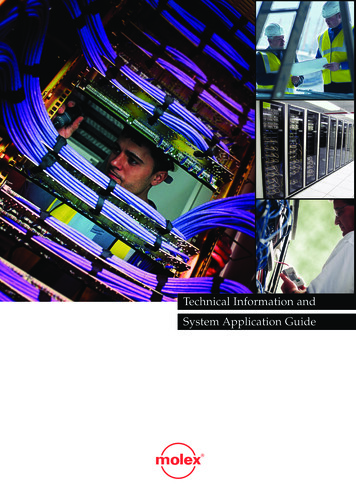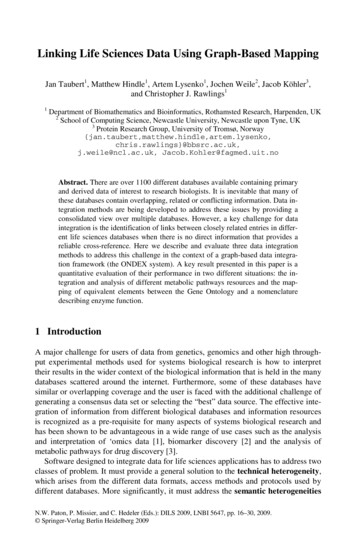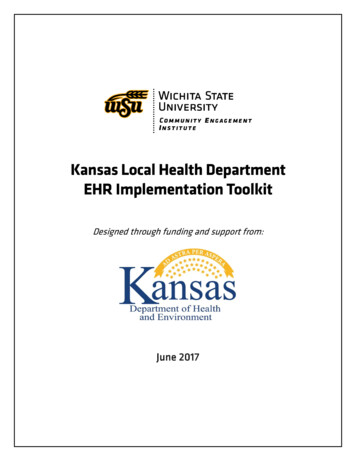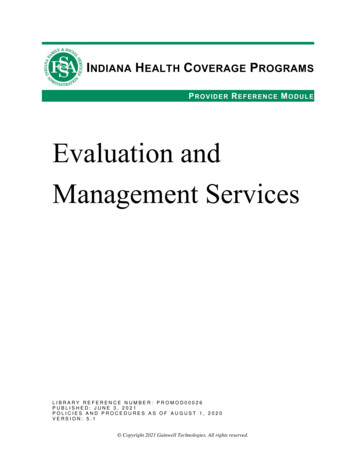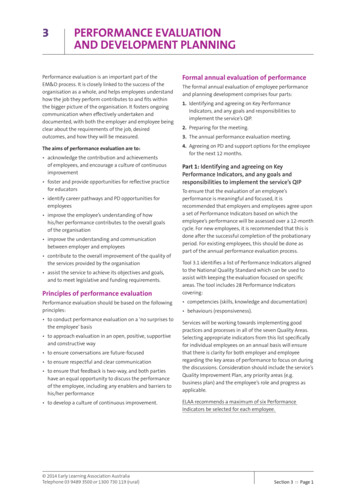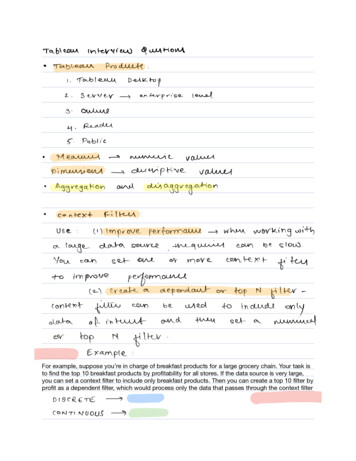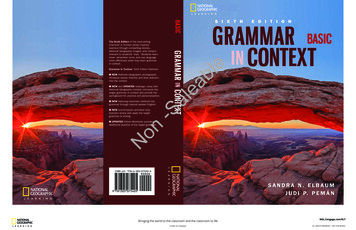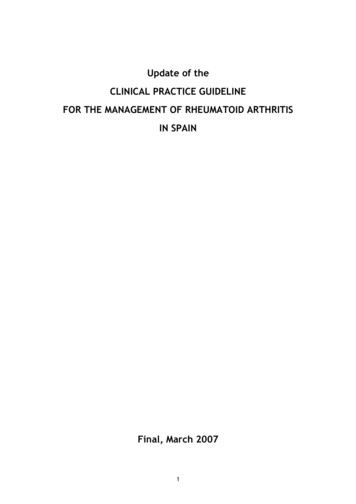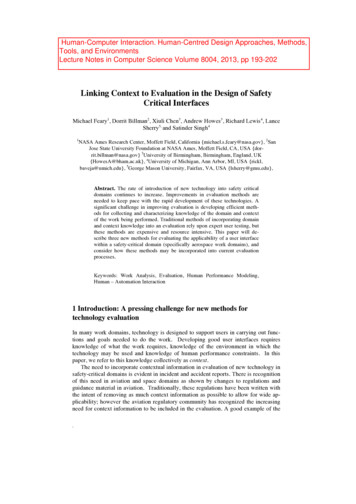
Transcription
Human-Computer Interaction. Human-Centred Design Approaches, Methods,Tools, and EnvironmentsLecture Notes in Computer Science Volume 8004, 2013, pp 193-202Linking Context to Evaluation in the Design of SafetyCritical InterfacesMichael Feary1, Dorrit Billman2, Xiuli Chen3, Andrew Howes3, Richard Lewis4, LanceSherry5, and Satinder Singh41NASA Ames Research Center, Moffett Field, California {michael.s.feary@nasa.gov}, 2SanJose State University Foundation at NASA Ames, Moffett Field, CA, USA {dorrit.billman@nasa.gov} 3University of Birmingham, Birmingham, England, UK{HowesA@bham.ac.uk}, 4University of Michigan, Ann Arbor, MI, USA {rickl,baveja@umich.edu}, 5George Mason University, Fairfax, VA, USA {lsherry@gmu.edu},Abstract. The rate of introduction of new technology into safety criticaldomains continues to increase. Improvements in evaluation methods areneeded to keep pace with the rapid development of these technologies. Asignificant challenge in improving evaluation is developing efficient methods for collecting and characterizing knowledge of the domain and contextof the work being performed. Traditional methods of incorporating domainand context knowledge into an evaluation rely upon expert user testing, butthese methods are expensive and resource intensive. This paper will describe three new methods for evaluating the applicability of a user interfacewithin a safety-critical domain (specifically aerospace work domains), andconsider how these methods may be incorporated into current evaluationprocesses.Keywords: Work Analysis, Evaluation, Human Performance Modeling,Human – Automation Interaction1 Introduction: A pressing challenge for new methods fortechnology evaluationIn many work domains, technology is designed to support users in carrying out functions and goals needed to do the work. Developing good user interfaces requiresknowledge of what the work requires, knowledge of the environment in which thetechnology may be used and knowledge of human performance constraints. In thispaper, we refer to this knowledge collectively as context.The need to incorporate contextual information in evaluation of new technology insafety-critical domains is evident in incident and accident reports. There is recognitionof this need in aviation and space domains as shown by changes to regulations andguidance material in aviation. Traditionally, these regulations have been written withthe intent of removing as much context information as possible to allow for wide applicability; however the aviation regulatory community has recognized the increasingneed for context information to be included in the evaluation. A good example of the.
introduction of a requirement for context information is illustrated by European Aviation Safety Agency (EASA) Certification Specification 25.1302, below:“This installed equipment must be shown, individually and in combination withother such equipment, to be designed so that qualified flight-crew members trained inits use can safely perform their tasks associated with its intended function by meetingthe following requirements:(a) Flight deck controls must be installed to allow accomplishment of thesetasks and information necessary to accomplish these tasks must be provided.(b) Flight deck controls and information intended for flight crew use must:(1) Be presented in a clear and unambiguous form, at resolution andprecision appropriate to the task.(2) Be accessible and usable by the flight crew in a manner consistent with the urgency, frequency, and duration of their tasks, and(3) Enable flight crew awareness, if awareness is required for safeoperation, of the effects on the aeroplane or systems resulting fromflight crew actions.(c) Operationally-relevant behaviour of the installed equipment must be:(1) Predictable and unambiguous, and(2) Designed to enable the flight crew to intervene in a manner appropriate to the task.(d) To the extent practicable, installed equipment must enable the flight crewto manage errors resulting from the kinds of flight crew interactions with theequipment that can be reasonably expected in service, assuming the flightcrew is acting in good faith.” (EASA CS25.1302)This new regulation presents challenges to the state of the art evaluation methods, byexplicitly requiring context information (stated as task characteristics) to be includedin the certification and approval process. In addition, this regulation calls for methodsthat can be used to demonstrate alignment between the task and the intended functionof the technology under evaluation.Given these requirements, this paper will provide a brief background of usabilityevaluation in safety-critical interface evaluation. We will then describe three candidatemethods for evaluating the applicability of a user interface within a work context, andconsider how these methods may be incorporated into current evaluation processes.We will also show how the three methods can be used independently or linked to provide different levels of resolution for the different evaluation requirements.2 Human-Automation Interaction Evaluation and Safety CriticalDomainsWe begin by examining the characteristics of the aviation and space domains we havebeen involved in. We have noticed five characteristics that we believe place significant constraints on effective methods for evaluating Human-Automation Interactionmethods.
0.1 The work is performed by experts, and access to experts may be limited.Analysts and designers may share a part of the domain expert's knowledge, butoperational expertise is required for evaluation. Limited access can be a keyconstraint, particularly when simple observation is insufficient. In addition, thepopulation of experts evaluators may be reduced to the point that that the overallevaluation has limited utility (Faulkner, 2003; Macefield, 2009). Access to staticexpertise in documentation or training materials may be of limited value for manyreasons, including reliance on specific procedures that may change, be obsolete, orbe operationally invalid. Further, even when usability assessments are conductedby usability experts, assessment done by different experts may vary considerablyin both the nature and severity of problems identified (Molich et al 2010).0.2 The systems are increasingly complex and interactive. The dynamics andcomplexity of interactive systems may make it difficult to identify and explicitlydefine and present situations for evaluation. (Feary, 2005)0.3 The cognitive activity may be difficult to understand from observation. Theremay be few external cues about internal processes, although these hard-to-observeactivities may be very critical parts of work. (Caulton, 2001)0.4 It is often difficult to clearly separate the work to be done and the functionalityused to accomplish it with new technology. Use of automation can change thenature of the work being accomplished to the extent that it is difficult to separatethis work from the functionality provided by the new technology. For example,navigation is a critical work activity in aviation and space domains, and there aremany different means available for accurate navigation. If the work, in this casefinding one’s way from point A to point B, can be separated from the functionalityused to accomplish it (e.g. using a GPS navigation system), it is possible togenerate evaluation methods which are more broadly applicable to newtechnologies. This characteristic is true in many information work domains.0.5 There is a need for methods usable early in the development process. This isproblem that is not unique to safety critical domains. In the aviation community,the FAA has recognized this need in its’ 2012 workplan, by stating that“Consideration of the safety aspects must be embedded within the initial conceptdevelopment – otherwise, whole aspects of the technology or operational conceptmay need revision in order to ensure safety.” It can be difficult to providefunctionality that behave enough like the final product early in the design processto be valid for user testing, and it may be too expensive to resolve issuesdiscovered late. Therefore, user interface evaluation in safety-critical domainsrequires an increased emphasis on methods beyond user testing.The need for improved evaluation methods is becoming more apparent when thesecharacteristics are combined with the increasing pace of development of technologies.Specifically the rate of development of information automation being proposed in
safety-critical domains has increased dramatically in the last decade. The volume ofcandidate automation concepts being presented also highlights the need for more efficient methods to meet the schedule requirements of the often large, expensive andcomplex safety critical design projects that typically allow limited time for evaluation.The need for methods that can respond to the increase in the number of technologiesrequiring evaluation—and their combinations in particular contexts—has been recognized by the safety-critical organizations, (US FAA, 2012; EASA, 2007).3 Three Methods for Integrating Context into the Evaluation ofSafety-Critical InterfacesIn the previous section, we discussed the need for new Human – Automation Interaction evaluation methods. In this section we will discuss three candidate methods,Work Technology Alignment Analysis, Task Specification Language and OptimalControl Modeling.3.1 Work - Technology Alignment (WTA) AnalysisThe first method, Work-Technology-Alignment, evaluates how well technology alignswith the structure of the work it is intended to support (Billman, et al., 2010, 2011, inpreparation). Technology that is better aligned with a domain of work activity shouldsupport more effective performance, in that domain. Assessment of alignment dependson discovering the elements and organization of the work domain, and on assessinghow well the entities and organization of the technology corresponds with that neededfor the work domain. The method uses Needs Analysis to identify the elements andstructure of the work and integrates proposals from several research traditions in HAI,Human Computer Interaction (HCI), Work Domain Analysis (WDA), and relateddisciplines to form the analysis. The goal of the analysis is to help identify wherework and the functionality used to accomplish the work are not aligned, and to helpprovide insight into how to provide better alignment, and therefore improve HumanTechnology performance.High technology - work structural alignment means that there is a strong match atthe level of particular elements (entities, relations, and operations), and that the organization of elements in the technological system (the “system”) aligns with theorganization of elements in the work domain. Conversely, a design might have weakWTA alignment for several reasons: Elements of the work are not represented in the system (missing functions);Elements of the system are unrelated to the work (system overhead or irrelevant "features"); orElements in the work domain and elements of the system are organized differently.We predict that systems with high alignment will provide multiple benefits: fasterand more accurate performance; less training; better skill retention; and successful
operation over a wider range of goals or situations, including novel, infrequent, oremergency conditions.An initial study assessed alignment to evaluate the technology used in a spaceflight control work, specifically, software for planning flight activities of the International Space Station. This included a needs analysis of the work structure, an analysisof legacy technology, and redesign of software guided by the alignment to the workstructure. Figure 1 illustrates the improved alignment of the redesigned system.Based on these analyses, performance differences were predicted using legacy versusredesigned systems. Predictions were tested in a comparative experiment using tasksand material closely matching a subset of real operator work. Performance using therevised prototype had half the errors and took half the time, for critical tasks revisingthe scheduled time of events.This case study suggests the Work-Technology Alignment evaluation methodshould be further developed as a means for incorporating context information inevaluations of complex, safety-critical technology. Research in progress is developingmore structured methods of representing work, representing the technology, and comparing these representations.Panel A: Legacy softwarePanel B: Redesigned softwareFigure 1. Shaded representations and operations indicate aspects of the domainstructure that are not expressed in the software. Differences in relations are notedin the key. The redesigned prototype aligns much better with the domain structure.Performance was better with the redesign, and particularly in tasks that tapped intopoints of greatest difference in alignment.
3.2 Task Specification Language (TSL)The second method, analysis based on Task Specification Language (TSL) (Sherry etal., 2009) provides a task structure that can be applied to a wide variety of domains fordetailed evaluation. This method maps traditional task analysis information into amore usable format, integrates contextual information, and responds to the need formethods and tools that do not require extensive expertise to implement and interpret.The goal is to provide a framework for developers and evaluators to think about thework activity (task), how the task is triggered, and the cues provided to the user toenable task completion and monitoring of task completion. The method may be usedindependently to identify issues in development, or used to provide input to computational models.TSL is an approach to documenting the cognitive operations required by the usersto perform mission tasks providing a framework for a more structured CognitiveWalkthrough (Wharton et al., 1992) and can be enhanced to use recently available“affordable models of human performance,” to emulate Simulated User Testing.The TSL specifically categorizes operator actions into the following categories:1.2.3.4.5.6.Identify mission task and objectivesSelect appropriate automation function to perform the mission taskAccess the appropriate display, panel, page for the automation functionEnter the appropriate informationConfirm and Verify entriesMonitor progress and Initiate Intervention or New Tasks of the automationrelative to the objectives of the mission task and initiate intervention if required.A key contribution of TSL is the focus on failures to identify the correct mission task,or failures to select the appropriate automation function, and failures to monitor progress. These operator actions are exclusively decision-making actions that rely heavilyon cues in the cockpit and recall of memorization items. When cues are ambiguous orare not sufficiently salient, human operators have been documented to exhibit poorreliability. Every operator action category has its own set of unique cues to guide operator actions and their own set of pitfalls. For example, the reliability of the Enteractions are affected by the ergonomics of the input devices. The reliability of the Access actions are determined by the location and user-interface navigation design.The inclusion of all 6 steps of TSL allow for the method to be used independently,but the intention of future work is to enable steps 3, 4 and 5 to be automated, and theinformation collected in steps in 1 and 2 to be used in computational methods to enable steps 3, 4 and 5 to be automated.3.3 Optimal Control Modeling (OCM)The third method makes use of optimal control modeling to predict the strategies thatpeople will adopt given specifications of (1) human information processing architecture, (2) the subjective utility functions that people adopt, and (3) the person’s experi-
ence of the task environment. This approach uses cognitive architecture in context,and generates strategies for interaction with automation (Howes, et al., 2009; Lewis etal., (2012); Payne et al., in press; Eng et al (2006)). This work utilizes the contextualinformation in the form of cognitive architecture constraints, and fits well with thespecific characteristics that safety-critical domains tend to provide, such as a population of expert users as the basis for evaluation.The approach is based on a theoretical framework for the behavioral sciences thatis designed to tackle the adaptive, ecological and bounded nature of human behavior(Lewis et al., 2004; Howes et al., 2009). It is designed to help scientists and practitioners reason about why people choose to behave as they do and to explain whichstrategies people choose in response to utility, ecological context, and cognitive information processing mechanisms. A key idea is that people choose strategies so as tomaximize utility given constraints. In this way, the method provides an analyticmeans to predict and understand behavior as a function of the elements of contextidentified at the outset of this paper: the goals of the work are represented in explicitutility functions; the environments of training and performance are represented in theecological context, and the human performance constraints are represented in the explicit assumptions about cognitive mechanisms. Payne and Howes (in press) andLewis et al. (2004) illustrate the framework with a number of examples includingpointing, multitasking, visual attention, and diagnosis. Importantly, these examplesspan from perceptual/motor coordination, through cognition to collaborative interaction.Lewis et al’s (2012) model of simple word reading brings together three threadsthat are critical to understanding cognition in the cockpit: (1) mathematical models ofeye movement control (Engbert et al., 2005; Reichle, Rayner, & Pollatsek, 2003); (2)work on how higher-level task goals shape eye movement strategies (Rothkopf, Ballard, Hayhoe, & Regan, 2007; Ballard & Hayhoe, 2009; Salverda, Brown, & Tanenhaus, 2011); and (3) Bayesian sequential sampling models of lexical processing andperception (Norris, 2009; Wagenmakers, Ratcliff, Gomez, & McKoon, 2008). Themodel is an instantiation of a more general architecture for the control of active perception and motor output in service of dynamic task goals. The model decomposes theproblem into optimal state estimation and optimal control, mediated by an informationprocessing architecture with independently justified bounds.Eng et al. (2006) report a model of the time taken and working memory loads required to perform simple tasks with Boeing Flight Deck of the Future (FDF) and existing 777 interfaces. Critically, optimal control modeling was used to select the strategies for both interfaces. The FDF performed better than the 777 for both time andworking memory conditions. Across both tasks, the FDF consistently supported astrategy that allowed for a lower working memory load compared to the best caseworking memory load in the 777 (in one task by 175 milliseconds and in another by1375 milliseconds). The FDF also performed better on time on task than the 777 (inone task by 100 milliseconds and in another by 500 milliseconds). These results validated the explicit design objectives behind the FDF interface. The interface comes atno cost to the time required to complete tasks while enabling a better distribution ofworking memory load. The success of the modeling was critically dependent on optimal control modeling to determine the predicted strategies because without this crucial constraint it is possible for the models to use almost any strategy on each of the
two interfaces. Model fitting without such constraints, which is a more commonmeans of modeling human behavior, could not make any predictive discriminationsbetween the two interfaces.In new work we are developing models and empirically investigating how pilotsswitch attention between aviation and navigation tasks. In the model Bayesian stateestimation is used to maintain a representation of two variables: (1) the aircraft attitude and (2) the body-centric location of FMS buttons. The scheduling of eyemovements between attitude indicators and the FMS are determined by the utilityassociated with the accuracy of these state estimates. Inaccurate estimates of buttonlocations leads to data entry errors. Inaccurate estimates of attitude lead to poor situation awareness. Depending on whether the pilot wishes to prioritize data entry, usingthe FMS, or awareness of attitude then an optimal schedule of eye-movements is selected by the control model. Future work will be focused on providing tools to support the use of the modeling approach in evaluation processes.4 SummaryIn this paper we presented the case for why context information is important in evaluation of Human-Automation interaction, why new evaluation methods are needed forsafety-critical systems and the characteristics of the problem that make it challenging.We then briefly described three candidate evaluation methods that have some promiseof meeting this challenge in different ways. Work Technology Alignment (WTA)analysis provides a mechanism and metric for overall assessment of technologyagainst the work context. The intention of the WTA assessment process is to producea body of structured information that enables comparing the technology, training andprocedures to a representation of the work to assess fitness-for-purpose.Task Specification Language (TSL) emphasizes the need to explicitly define themission tasks, and the accompanying functionality to complete the tasks, with themeans by which the human operator can monitor the task completion. TSL is designedto be used as an independent assessment tool, or in cooperation with a computationalmethod, such as an OCM model.Optimal Control Modeling (OCM) provides machinery to enable a more thoroughevaluation of safety-critical Human-Automation Interaction in the time limited evaluation process. The approach is to provide the model with functionality and context information—including assumptions about human information processing constraints—and then computationally generate rational strategies that could be used to achieve thework goals given those constraints. The strategy information generated by the analysescould then be used within existing evaluation processes to help identify HumanAutomation Interaction vulnerabilities. These methods collectively provide a pathforward for including context information into safety-critical work domain evaluations.
5 References1. Ballard, D. H., & Hayhoe, M. M. (2009). Modeling the role of task in the control ofgaze. Visual Cognition, 17(6-7), 1185-1204.2. Dorrit Billman, Michael Feary, Debra Schreckengost, and Lance Sherry. 2010. Needsanalysis: the case of flexible constraints and mutable boundaries. In CHI '10 Extended Abstracts on Human Factors in Computing Systems (CHI EA '10). ACM, New York, NY,USA,4597-4612.DOI 1753846.17542013. Billman, D., Arsintescucu, Lucia , Feary, M., Lee, J., Smith, A., and Tiwary, R. Benefits ofmatching domain structure for planning software: the right stuff. In Proceedings of theSIGCHI Conference on Human Factors in Computing Systems (CHI '11). ACM, New York,NY,USA,2521-2530.DOI 1978942.1979311 (2011)4. Billman,D., Arsintescu, L., Feary, M., Lee, J., Schreckenghost, D., & Tiwary, R. (inpreparation as NASA Technical Memorandum). Product-Based Needs Analysis and CaseStudy of Attitude Determination and Control Operator (ADCO) Planning Work.5. Caulton, D. A. (2001). Relaxing the homogeneity assumption in usability testing. Behaviour& Information Technology, 20(1), 1-7 (2001)6. Eng, K., Lewis, R. L., Tollinger, I., Chu, A., Howes, A., & Vera, A. (2006). Generatingautomated predictions of behavior strategically adapted to specific performance objectives.In Proceedings of the sigchi conference on human factors in computing systems (pp. 621–630).7. Engbert, R., Nuthmann, A., Richter, E. M., & Kliegl, R. SWIFT: a dynamical model ofsaccade generation during reading. Psychological review,112(4), 777 (2005)8. European Aviation Safety Agency, Certification Specification 25.1302 and AcceptableMeans of Compliance 25.1302 Installed Systems and Equipment for Use by the Flight Crew(2007)9. Faulkner, L. Beyond the five-user assumption: Benefits of increased sample sizes in usability testing. Behavior Research Methods, 35(3), 379-383, (2003)10. Feary, M. Formal Identification of Automation Surprise Vulnerabilities in Design, Doctorate Dissertation, Cranfield University (2005).11. Federal Aviation Administration AVS Workplan for Nextgen. Federal Aviation Administration , USA. (2012)12. Howes, A., Lewis, R.L. and Vera, A. Rational adaptation under task and processing constraints: Implications for testing theories of cognition and action Psychological Review(2009)13. Lewis, R., Shvartsman, M., and Singh, S. The adaptive nature of eye-movements in linguistic tasks: How payoff and architecture shape speed-accuracy tradeoffs, Topics in CognitiveScience (to appear).14. Macefield, R. How To Specify the Participant Group Size for Usability Studies: A Practitioner’s Guide. Journal of Usability Studies, 5(1), 34-45 (2009)15. Molich, R., Chattratichart, J., Hinkle, V., Jensen, J. J., Kirakowski, J., Sauro, J., . &Traynor, B. Rent a Car in Just 0, 60, 240 or 1,217 Seconds?-Comparative Usability Measurement, CUE-8. Journal of Usability Studies, 6(1), 8-24, (2010).
16. Norris, D. Putting it all together: A unified account of word recognition and reaction-timedistributions. Psychological Review, 116(1), 207, (2009)17. Payne, S. and Howes, A. Adaptive Interaction: A utility maximisation approach to understanding human interaction with technology, Morgan Claypool lecture (In Press).18. Reichle, E. D., Rayner, K., & Pollatsek, A. The EZ Reader model of eye-movement controlin reading: Comparisons to other models. Behavioral and brain sciences, 26(4), 445-476,(2003)19. Rothkopf, C. A., Ballard, D. H., & Hayhoe, M. M. Task and context determine where youlook. Journal of Vision, 7(14), (2007).20. Salverda, A. P., Brown, M., & Tanenhaus, M. K. A goal-based perspective on eye movements in visual world studies. Acta psychologica,137(2), 172-180, (2011).21. Sherry, L., Medina-Mora, M., John, B., Teo, L., Polson, P., Blackmon, M., . & Feary, M.System Design and Analysis: Tools for Automation Interaction Design and EvaluationMethods. Final Report NASA NRA NNX07AO67A (2010)22. Wagenmakers, E. J., Ratcliff, R., Gomez, P., & McKoon, G. A diffusion model account ofcriterion shifts in the lexical decision task. Journal of Memory and Language, 58(1), 140159, (2008).23. Wharton, C. Bradford, J. Jeffries, J. Franzke, M. Applying Cognitive Walkthroughs to moreComplex User Interfaces: Experiences, Issues and Recommendations CHI ’92 pp381–388.(1992)
Linking Context to Evaluation in the Design of Safety Critical Interfaces Michael Feary1, Dorrit Billman2, Xiuli Chen3, Andrew Howes3, Richard Lewis4, Lance Sherry5, and Satinder Singh4 1NASA Ames Research Center, Moffett Field, California {michael.s.feary@nasa.gov}, 2San Jose State Univers



